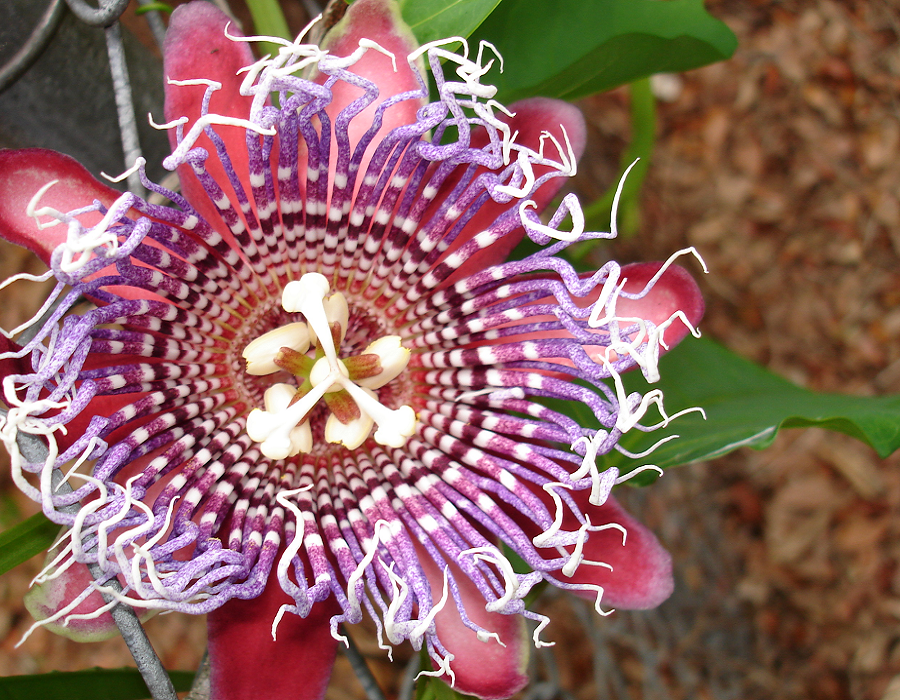The Giant Granadilla
Passiflora quadrangularis is the largest species of passionfruit in the world. The vines can climb to the top of a 100 foot tree and then cover the canopy. They, like other Passifloras are very fast growing and aggressively grab onto anything within reach of their tendrils. Their flowers are very large and showy, as well as fragrant. The fragrance is very sweet and strong, and carries on the breeze.
When many flowers are in bloom at the same time, you can smell them from across the yard. Since the flowers are pendulous, the best way to view them is from below, so a pergola or arbor makes a good place to grow these. The fruit, which ripens green, can be as large as a cantaloupe melon, though my vines here in Tampa Florida have never had fruit larger than an average grapefruit, but that is still larger than any other species I’ve ever grown. The pulp of the fruit is very sweet, but not as flavorful as Passiflora edulis. One unique characteristic of this species is that the rind is also edible, and lightly sweet. The texture of the rind resembles a dry pear.
There really isn’t any trick to growing this vine. The main thing will be protecting it from cold. Frost will kill it, and the size is so large that protecting them is difficult. Passiflora quadrangularis does much better in the ground than it does in a container, but it can be grown in a container. It will not flower or fruit as well in a container, though. It should not be grown in the ground in zones lower than USDA zone 9.
Origin
Brazil
Binomial nomenclature
Passiflora quadrangularis
Common names
Giant granadilla
Description
The 4-angled stems are prominently winged from the corners, and there are 12″ long axillary tendrils, between leaflike, ovate stipules. The alternate leaves are ovate, 3 1/4″ to 6″ wide, and 6″ to 8″ long. The solitary, fragrant flowers, up to 5″ wide, have 5 sepals and 5, 2″ long, petals that are reddish-pink; the corona filaments are purple-and-white below, blue in the middle and white at the tip.
The pleasingly aromatic, melon-sized fruit is longitudinally lobed; has a thin, pale green, skin which is often blushed with pink. Underneath that, is a layer of firm, mealy, white flesh, 1″ to 1 1/2″ thick, with a mild and sweet flavor. The central cavity is filled with juice and sweet-acid pulp, enclosing oval, dark brown seeds.
Height
The height is determined by whatever it is growing on. It has been shown to reach the top of 150′ trees in the tropics.
Temperature/Zone
Zone 9b, 33°F or higher. In colder climates, it will need to be kept in a container.
Light
Full sun.
Water
Keep them evenly moist. Once established, they are a bit more drought tolerant, but they will slow down or stop growing if kept too dry.
Fertilizer
I use an all purpose fertilizer. Do not fertilize during the Winter.
Cultivation
Passiflora quadrangularis likes a rich soil, high in organic matter. they tolerate the sandy soil in Central Florida, but they benefit from a deep layer of mulch.
Pests
I see butterflies laying eggs on my vines all the time, but the caterpillars don’t seem to be able to chew through the tough foliage. Those same caterpillars make short work of other Passiflora species. Mites sometimes attack Passiflora quadrangularis, causing their leaves to be dimpled and misshapen. Malathion will control the mites.
Morton, J. 1987. Giant Granadilla. p. 328–330. In: Fruits of warm climates. Julia F. Morton, Miami, FL


Dare mr.randy I would like to buy one passion fruit plant passion flora quadrangularis but it out of stock
When you have one can you let me know thank you
I am no longer growing this species. It is beautiful but it takes up too much space. I am now focussing my efforts of growing excellent fruiting cultivars of Passiflora edulis.